Non-Periodic Phenomena in Variable Stars
IAU Colloquium, Budapest, 1968
SYMBIOTIC STARS
Introductory Paper by
A. A. BOYARCHUK
Crimean Astrophysical Observatory, USSR
The term "symbiotic stars" was first introduced by P. W. Merill and now
is widely used for the designation of astronomical objects, whose
spectra represent a combination of absorption features of a low
temperature star with emission lines of high excitation. Several dozens
of such objects are known today. Bidelman's (1954) list contains 23
"stars with combination spectra". Mrs. Payne-Gaposchkin (1957)
attributed 32 objects to symbiotic stars. Most stars are common in both
lists. Four reviews of symbiotic stars were published for the last 10
years (Merrill, 1958; Payne-Gaposchkin, 1957; Sahade 1960, 1965) and
many problems, which have been mentioned, are still very important.
As far as this Colloquium is concerned with non-periodic phenomena, I
will concentrate your attention on such phenomena and will touch upon
other sides of the problem of symbiotic stars only when it is necessary.
First of all it is necessary to note that the criteria of "symbiotic
stars" above mentioned are rather rough. Many of long-period variables
as well as classical symbiotic stars like Z And satisfy such criteria.
As a result the lists of symbiotic stars given by Bidelman and by Mrs.
Payne-Gaposchkin are not homogeneous.
The detailed investigations of the typical symbiotic stars Z And, AC
Peg, AX Per, CI Cyg and BF Cyg give a possibility to propose the
following criteria for symbiotic stars. I. The absorption lines of
late-spectral type (TiO bands, CaI, CaII and al.) must be seen. II. The
emission lines of HeII, OIII or higher ionized atoms must be seen. The
widths of emission lines do not exceeded ~ 100 km/sec. III. The stellar
brightness can vary with an amplitude up to 3 magn. and with a period of
several years.
If the informations about a star correspond to the criteria mentioned,
then the star belongs with high probability to the group of symbiotic
stars. The list of those stars are found in Table 1. Table 2 lists the
stars, for which we have not all necessary informations and the known
data indicate only that they may be symbiotic stars.
LIGHT VARIATIONS
The irregular variations of brightness is one of the most characteristic
features of symbiotic stars. Their light curves can be considered as a
whole complex of small simultaneous flares. This circumstance has given
a possibility to name these stars as "novalike stars".
Table 1
N Name R. A. 1900 Dec. 1900 m_max m_min S_p em V_r P_rv P_m Ref.
1 2 3 4 5 6 7 8 9 10 11 12
1 AX Per 01h 29m 57s +53deg 44.9' 9.7m 13.4m M5III [FeVII] -110 630d Boyarchuk, 1988
2 VV 8 01 52 13 +52 24.8 14.3 G5III [OIII] -6 O'Dell, 1966
3 RX Pup 08 10 42 -41 24.0 11.1 14.1 M5III [FeVII] Swings and Struve
1941.
4 SY Mus 11 27 36 -64 52.0 11.3 12.3 M3III [OIII] 623 Henize, 1952
5 RW Hya 13 28 47 -24 52.1 10.0 11.2 M2III [OIII] +10 370d 370 Merrill, 1950a
6 AG Dra 16 01 07 +67 04.7 9.1 11.2 K3III HeII -140 Boyarchuk, 1966
7 HZ 177 16 39 34 -62 25.4 13.1 M [OIII] Webster, 1966
8 YY Her 18 10 18 +20 57.4 11.7 >13.2 M2III [OIII] Herbig, 1950
9 AR Pav 18 10 20 -66 07.0 10.2 12.7 M [OIII] -50 605 Sahade 1949
10 FR Set 18 17 46 -12 44.0 11.7 12.5 M2III [OIII] Bidelman, Stephenson,
1956
11 V443 Her 18 19 00 +23 24.0 12.4 12.6 M3III [OIII] -55 Tift, Greenstein,
1958
12 FN Sgr 18 48 01 -19 07.1 9 13.9 Pec. [OIII] -51 Herbig, 1950
13 CM Aql 18 58 22 -03 12.2 13.2 16.5 M4III HeII Herbig, 1960
14 BF Cyg 19 19 57 +29 28.8 9.3 13.5 M5III [OIII] +5 750d Boyarchuk, 1968a
15 My 129 19 33 18 -69 22.3 M3 [OIII] Thackeray, 1954
16 CI Cyg 19 46 30 +35 25.9 9.4 13.7 M5III [FeVII] +15 Boyarchuk, 1968a
17 V407 Cyg 20 58 41 +45 22.8 13.3 >16.5 Mep Merrill, Burwell
1950
18 MHalpha 19 55 12 +39 33.0 10 >15.5 M3III [OIII] -58 Boyarchuk, 1968b
328-116
19 AG Peg 21 46 11 +12 09.5 6.8 8.2 M3III [OIII] -16 800d 800d Boyarchuk, 1967a
20 Z And 23 28 51 +48 16.0 8.0 12.4 M2III [FeVII] -5 714d Boyarchuk, 1967b
21 R Aqr 23 38 39 -15 50.3 5.8 11.5 M7e [OIII] +15 26y, 3y 387d Merrill, 1950b
Table 2
N Name R. A. 1900 Dec. 1900 m_max m_min S_p em. V_r Ref.
1 2 3 4 5 6 7 8 9 10
1 HD 4174 00^h41^m54^s 40deg 24.0' 7.5m M2III [OIII] -101 Wilson, 1950
2 DV Aur 05 15 18 +32 24.7 8.2 10.0 C5 [OIII] Sanford, 1944
3 Hz 134 15 41 04 -66 18.5 15 [OIII] Webster, 1966
4 HD 330 036 15 47 15 -48 42 11.7 [OIII] Webster, 1966
5 Hz172 16 29 45 -55 38 12.9 [OIII] Webster, 1966
6 MH_alpha 276-52 16 45 06 -25 49 11.5 [FeVII] Merrill, Burwell, 1950
7 HK Sco 16 48 17 -30 13.7 13.1 15.8 Pec. HeII Elvey, 1941
8 V 455 Sco 17 00 47 -33 57.9 12.8 >16.5 Com. H Merrill, Burwell, 1950
9 MH_alpha 276-12 17 05 42 -32 28 17 [FeVII] Merrill, Burwell, 1950
10 MH_alpha 79-52 17 37 24 -22 43 12 [FeVII] Merrill, Burwell, 1950
11 MH_alpha 359-110 17 45 00 -22 17 11 [FeVII] Merrill, Burwell, 1950
12 KW Sco 17 45 42 -27 59.8 11.0 13.2 Mp Swope, 1940
13 F 6-7 17 59 36 -20 21 11 M3 H Merrill, Burwell, 1950
14 Y CrA 18 07 12 -42 52.3 12.0 12.9 Pec. Bidelman, 1954
15 MH_alpha 305-6 18 59 18 +16 18 11.5 [FeVII] Merrill, Burwell, 1950
16 MH_alpha 80-5 19 41 24 +18 22 11 Com. H Merrill, Burwell, 1950
It is necessary to mention that different stars have rather different
light curves. Moreover, the character of the light curve of the same
star varies strongly from time to time. Many astronomers have observed
light variations of symbiotic stars for many years. Now we shall briefly
consider the results of the observations of several symbiotic stars.
Fig. 1 shows the light curve of Z And. The papers by Prager (1941),
Payne-Gaposchkin (1964), Erleksova (1964), Beljakina (1968), were used
for the construction of the curve.
The light variations of Z And have a rather complicated character. There
are periods, when the stellar brightness changes very little, for
instance in 1905-1913. On the other hand the star flared up to 4^m in
1914 and 1939. Quite a few flares with smaller amplitude were observed
in other years. In 1920-1931 the light variations had a quasi-periodic
character. According to photoelectric observation (Belyakina, 1968) the
light variations were very complicated after 1960. Mrs. Payne-Gaposchkin
(1945) found light maxima following one after another in 714 days. But
departures from the average period can reach hundred days in several
cases. On the whole one can say that non-periodic processes play a very
important role in the case of Z And.
Fig. 2 shows the light curve of BF Cyg, which was constructed on the
basis of the papers by Jacchia (1941), Aller (1954), Wachmann (1961) and
Romano (1966). We can see that the light curve of BF Cyg is similar to
that of Z And. Here we also have periods for small variations, for
instance for 1929-1931. A rather large flare was observed in 1955. The
quasi-periodic variations of the brightness of BF Cyg are smaller than
those of Z And, the non-periodic part is very important here.
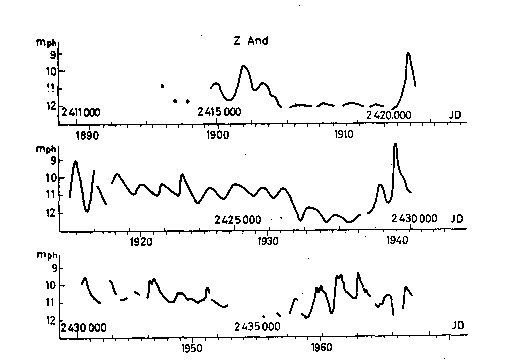 Fig. 1
Fig. 1
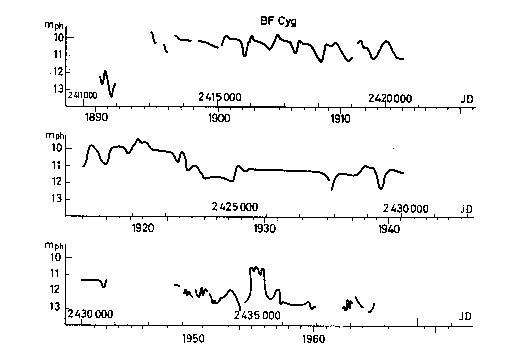 Fig. 2
Fig. 3 shows the light curve of CI Cyg, which was constructed on the
basis of papers by Greenstein (1937), Aller (1954) and Hoffleit (1968).
The brightness of the star varied generally with small amplitude. Rather
large flares were observed only twice, in 1911 and in 1958. Mrs. Hoffleit
has found that quasi-periodic variations have a period of 815^d.
We can see the form of those variations in Fig. 4, which was adopted
from Hoffleit's paper (1968). The scattering on that figure is large. It
means that non-periodic variations are important.
Fig. 5 shows the light curve of AX Per, which was constructed on the
basis of papers by Lindsay (1932), Payne-Gaposchkin (1946), Wenzel (1956),
Sieder (1956) and Romano (1960). On the whole the light variations of AX Per
are similar to those of Z And.
The light variations of AG Peg have different character. Fig. 6 shows
the light curve of AG Peg from 1825 on. The symbols are as follow
filled circle-m_vis, X-m_ph, triangle-u, square-B, circle-V.
The original data were published by Lundmark (1921), Himpel (1942),
Sandig (1950), Payne-Gaposchkin (1950), Mayall (1964) and Belyakina (1965).
In general terms the light curve of AG Peg resembles that of a slow
developed flare. Using more detailed observations in the last years
(Mayall, 1964, Belyakina, 1965) Miss Belyakina discovered the periodical
variation of brightness with P = 800^d and Delta m ~ 0.3m. This is easy to see
in Fig. 7. The symbols are: circle-visual, filled circle-photoelectric V.
Special photoelectric observations of the light variation of symbiotic
stars (Belyakina 1965, 1967) have shown, that many of them show rapid light
variations with small amplitudes and such variations have a non-periodic
character. Some examples are shown in Fig. 8 (Z And) and in Fig. 9 (AG Dra).
In these figures the dots correspond to brightness differences between the
symbiotic star and the comparison stars, and the crosses correspond to those
between two standard stars. The largest short-time variations have been
observed in the ultraviolet.
Fig. 2
Fig. 3 shows the light curve of CI Cyg, which was constructed on the
basis of papers by Greenstein (1937), Aller (1954) and Hoffleit (1968).
The brightness of the star varied generally with small amplitude. Rather
large flares were observed only twice, in 1911 and in 1958. Mrs. Hoffleit
has found that quasi-periodic variations have a period of 815^d.
We can see the form of those variations in Fig. 4, which was adopted
from Hoffleit's paper (1968). The scattering on that figure is large. It
means that non-periodic variations are important.
Fig. 5 shows the light curve of AX Per, which was constructed on the
basis of papers by Lindsay (1932), Payne-Gaposchkin (1946), Wenzel (1956),
Sieder (1956) and Romano (1960). On the whole the light variations of AX Per
are similar to those of Z And.
The light variations of AG Peg have different character. Fig. 6 shows
the light curve of AG Peg from 1825 on. The symbols are as follow
filled circle-m_vis, X-m_ph, triangle-u, square-B, circle-V.
The original data were published by Lundmark (1921), Himpel (1942),
Sandig (1950), Payne-Gaposchkin (1950), Mayall (1964) and Belyakina (1965).
In general terms the light curve of AG Peg resembles that of a slow
developed flare. Using more detailed observations in the last years
(Mayall, 1964, Belyakina, 1965) Miss Belyakina discovered the periodical
variation of brightness with P = 800^d and Delta m ~ 0.3m. This is easy to see
in Fig. 7. The symbols are: circle-visual, filled circle-photoelectric V.
Special photoelectric observations of the light variation of symbiotic
stars (Belyakina 1965, 1967) have shown, that many of them show rapid light
variations with small amplitudes and such variations have a non-periodic
character. Some examples are shown in Fig. 8 (Z And) and in Fig. 9 (AG Dra).
In these figures the dots correspond to brightness differences between the
symbiotic star and the comparison stars, and the crosses correspond to those
between two standard stars. The largest short-time variations have been
observed in the ultraviolet.
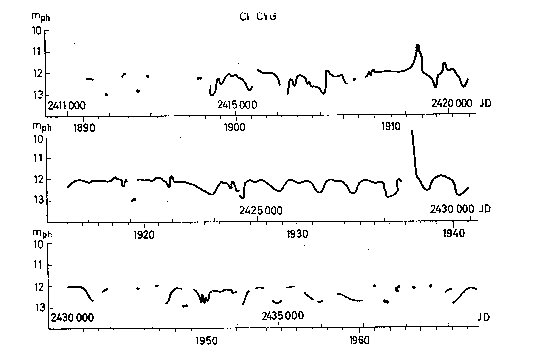 Fig. 3
Fig. 3
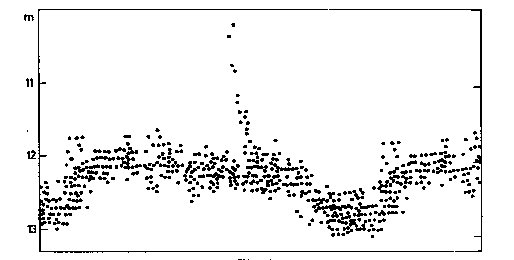 Fig. 4
Fig. 4
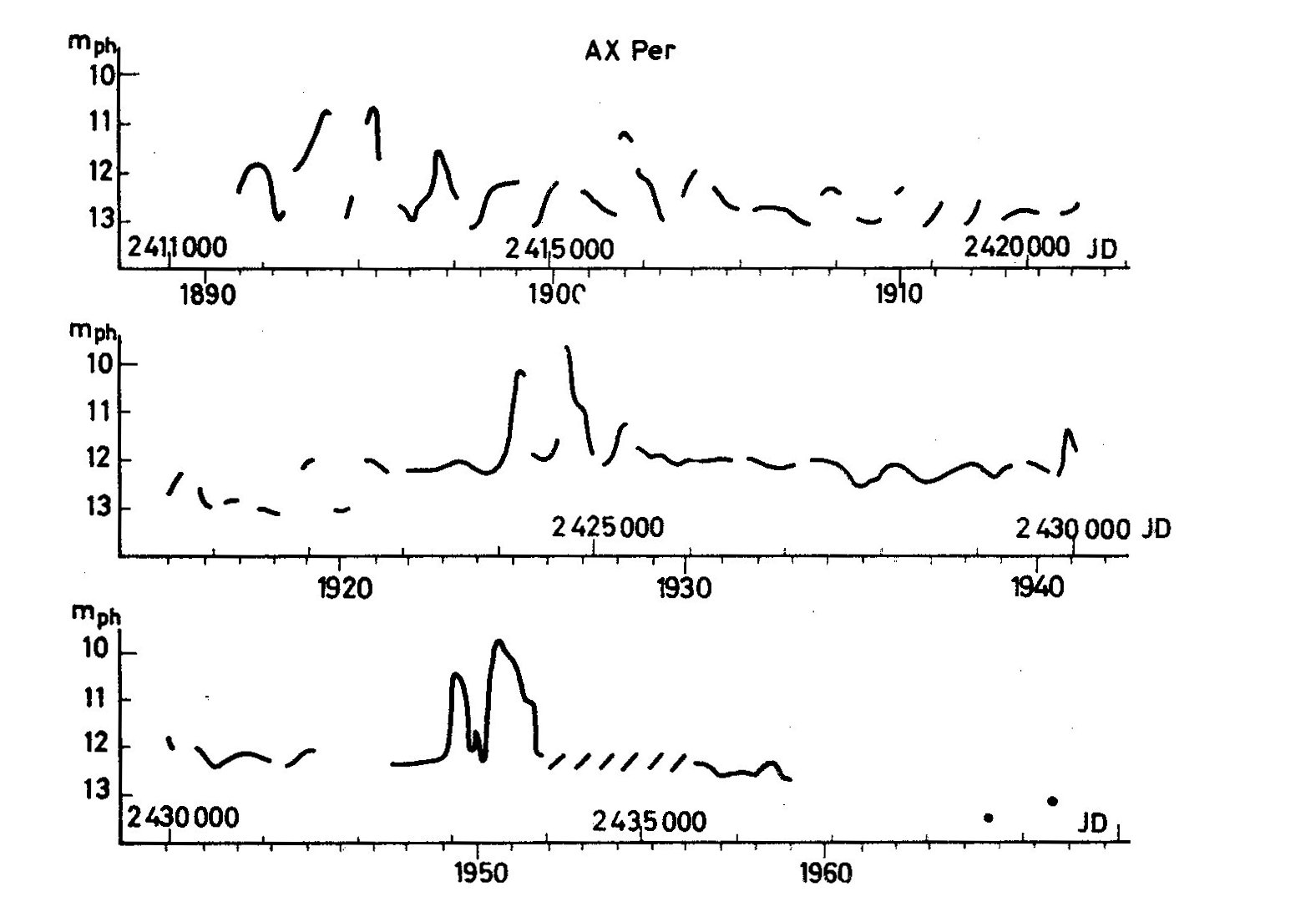 Fig. 5
Thus the available observations show that non-periodic processes play a
very important role in the light variation of symbiotic stars.
The brightness variations of symbiotic stars are accompanied by color
variations. As it was noted by Jacchia (1941), Himpel (1941), Payne-Gaposchkin
(1946) and al., the value m_ph-m_v increases with decreasing brightness,
i.e. star becomes redder. Belyakina's photoelectric observations confirm this
statement, moreover, she has shown, that the U-B color decreases with
decreasing stellar brightness, i.e. the ultraviolet excess increases.
Fig. 5
Thus the available observations show that non-periodic processes play a
very important role in the light variation of symbiotic stars.
The brightness variations of symbiotic stars are accompanied by color
variations. As it was noted by Jacchia (1941), Himpel (1941), Payne-Gaposchkin
(1946) and al., the value m_ph-m_v increases with decreasing brightness,
i.e. star becomes redder. Belyakina's photoelectric observations confirm this
statement, moreover, she has shown, that the U-B color decreases with
decreasing stellar brightness, i.e. the ultraviolet excess increases.
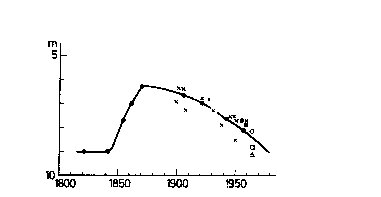 Fig. 6
Fig. 6
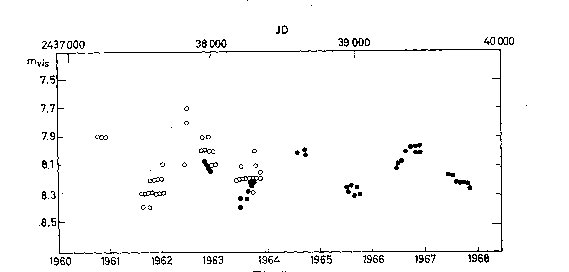 Fig. 7
Fig. 7
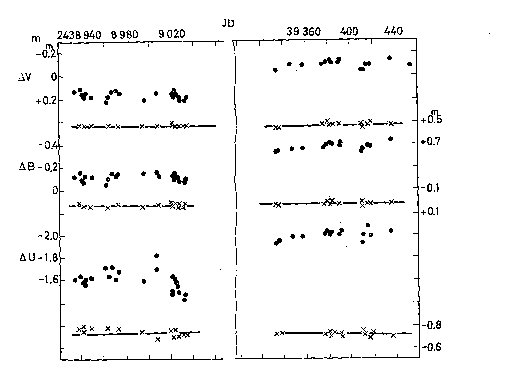 Fig. 8
Fig. 8
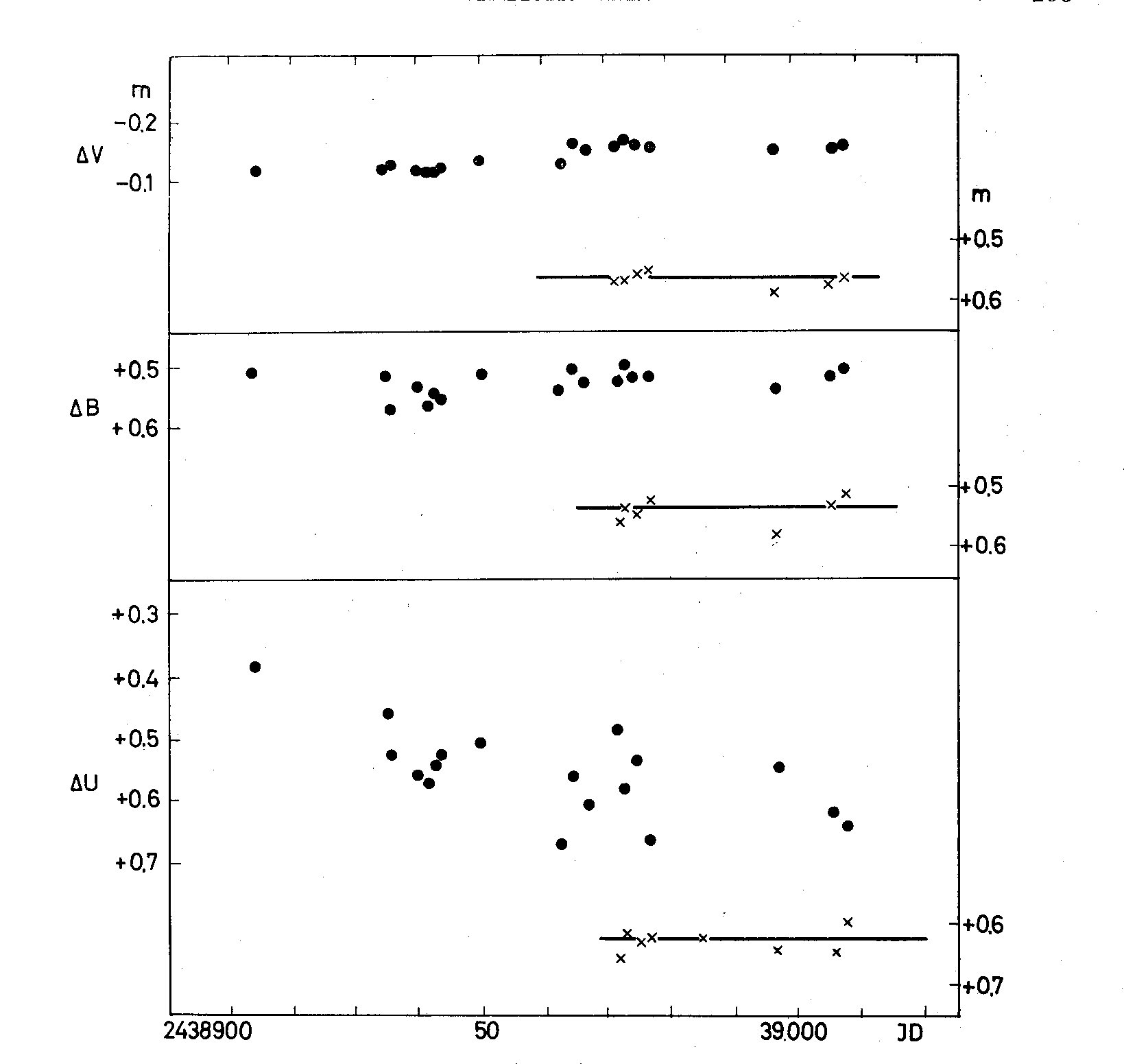 Fig. 9
SPECTRAL VARIATIONS
The character of spectra of symbiotic stars also changes together with
the light variations. Already in 1934 Hogg (1934) noted that features of
a late type spectrum strengthened when the brightness of Z And decreased.
At the same time the excitation degree of the emission spectrum increased.
Later similar changes of the spectrum were found for other symbiotic
stars.
Fig. 10 shows the intensity tracing of spectra of AX Per taken in 1964,
at m_ph = 13.5m, and in 1965, at m_ph = 12.8m. We can see that the intensities
of the [FeVII] and He II lines appreciably decreased in comparison with those
of hydrogen when the stellar brightness increased by 1 mag. At the same time
the intensity of the TiO bands strongly decreased.
Swings and Struve (1941a) have recognized that during the large flare of
Z And in 1939 its spectrum underwent great changes. Late-type absorption
features as well as highly excited emission lines disappeared
completely. But absorption lines usually observed in the spectra of
A0-A2 type stars were seen in the spectra of Z And. The hydrogen and
neutral helium emission lines had absorption companions. At that time
the spectrum of Z And was very similar to that of P Cyg type stars.
According to Miss Bloch (1964) such changes were also observed during
the large flare in 1961. Similar changes took place in the spectrum of
AX Per during a flare in 1955 (Gauzit 1955). Unfortunately, the number
of spectral observations of symbiotic stars is much less than those of
the brightness, and we can only suppose that during large flares of
other symbiotic stars similar changes took place in the spectra.
Fig. 9
SPECTRAL VARIATIONS
The character of spectra of symbiotic stars also changes together with
the light variations. Already in 1934 Hogg (1934) noted that features of
a late type spectrum strengthened when the brightness of Z And decreased.
At the same time the excitation degree of the emission spectrum increased.
Later similar changes of the spectrum were found for other symbiotic
stars.
Fig. 10 shows the intensity tracing of spectra of AX Per taken in 1964,
at m_ph = 13.5m, and in 1965, at m_ph = 12.8m. We can see that the intensities
of the [FeVII] and He II lines appreciably decreased in comparison with those
of hydrogen when the stellar brightness increased by 1 mag. At the same time
the intensity of the TiO bands strongly decreased.
Swings and Struve (1941a) have recognized that during the large flare of
Z And in 1939 its spectrum underwent great changes. Late-type absorption
features as well as highly excited emission lines disappeared
completely. But absorption lines usually observed in the spectra of
A0-A2 type stars were seen in the spectra of Z And. The hydrogen and
neutral helium emission lines had absorption companions. At that time
the spectrum of Z And was very similar to that of P Cyg type stars.
According to Miss Bloch (1964) such changes were also observed during
the large flare in 1961. Similar changes took place in the spectrum of
AX Per during a flare in 1955 (Gauzit 1955). Unfortunately, the number
of spectral observations of symbiotic stars is much less than those of
the brightness, and we can only suppose that during large flares of
other symbiotic stars similar changes took place in the spectra.
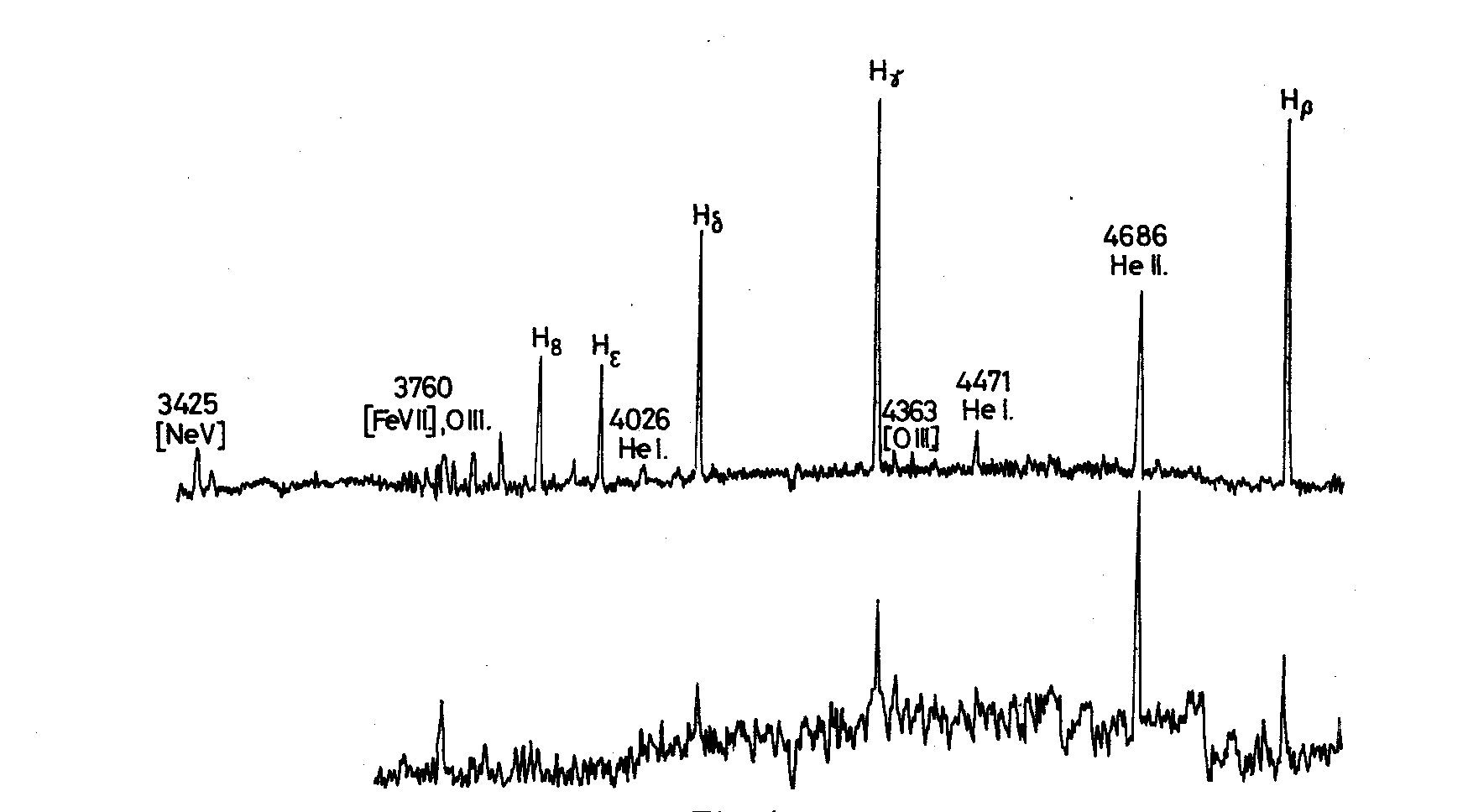 Fig. 10
The energy distribution in the continuous spectra of symbiotic stars
has been investigated by many authors (Tcheng Mao Lin, Bloch 1952, 1954,
Ivanova 1960, Boyarchuk 1967 and al.). The results of these investigations
are in good agreement with those of color variation. In Fig. 11 the solid
lines represent the observed energy distribution in the spectrum of Z And for
different data. It is seen that the energy distribution becomes steeper and
the Balmer jump increases when the star becomes fainter.
The displacement of different lines, or the radial velocities can give
important informations about the processes in symbiotic stars. At present a
rather large number of measurements of radial velocities for five stars:
AG Peg, BF Cyg, Z And, RW Hya and R Aqr have been published mainly by Merrill
and by Swings and Struve (1941-1943). The variations of radial velocities have
periodic character for four stars: AG Peg, BF Cyg, RW Hya and R Aqr.
The velocity curves of the stars mentioned are represented in Fig. 12. This
figure brings into evidence the binary nature of symbiotic stars. It should
be noted that AG Peg shows progressive changes of radial velocity as well as
periodic variations. Table 3, which was compiled by using Merrill's data (1929,
1942, 1951a, b, 1959) contains data about the average velocities
determined from the displacements of different lines. Boyarchuk (1967)
has explained this phenomenon by the decreasing opacity of an envelope
and by the changing excitation conditions.
Fig. 10
The energy distribution in the continuous spectra of symbiotic stars
has been investigated by many authors (Tcheng Mao Lin, Bloch 1952, 1954,
Ivanova 1960, Boyarchuk 1967 and al.). The results of these investigations
are in good agreement with those of color variation. In Fig. 11 the solid
lines represent the observed energy distribution in the spectrum of Z And for
different data. It is seen that the energy distribution becomes steeper and
the Balmer jump increases when the star becomes fainter.
The displacement of different lines, or the radial velocities can give
important informations about the processes in symbiotic stars. At present a
rather large number of measurements of radial velocities for five stars:
AG Peg, BF Cyg, Z And, RW Hya and R Aqr have been published mainly by Merrill
and by Swings and Struve (1941-1943). The variations of radial velocities have
periodic character for four stars: AG Peg, BF Cyg, RW Hya and R Aqr.
The velocity curves of the stars mentioned are represented in Fig. 12. This
figure brings into evidence the binary nature of symbiotic stars. It should
be noted that AG Peg shows progressive changes of radial velocity as well as
periodic variations. Table 3, which was compiled by using Merrill's data (1929,
1942, 1951a, b, 1959) contains data about the average velocities
determined from the displacements of different lines. Boyarchuk (1967)
has explained this phenomenon by the decreasing opacity of an envelope
and by the changing excitation conditions.
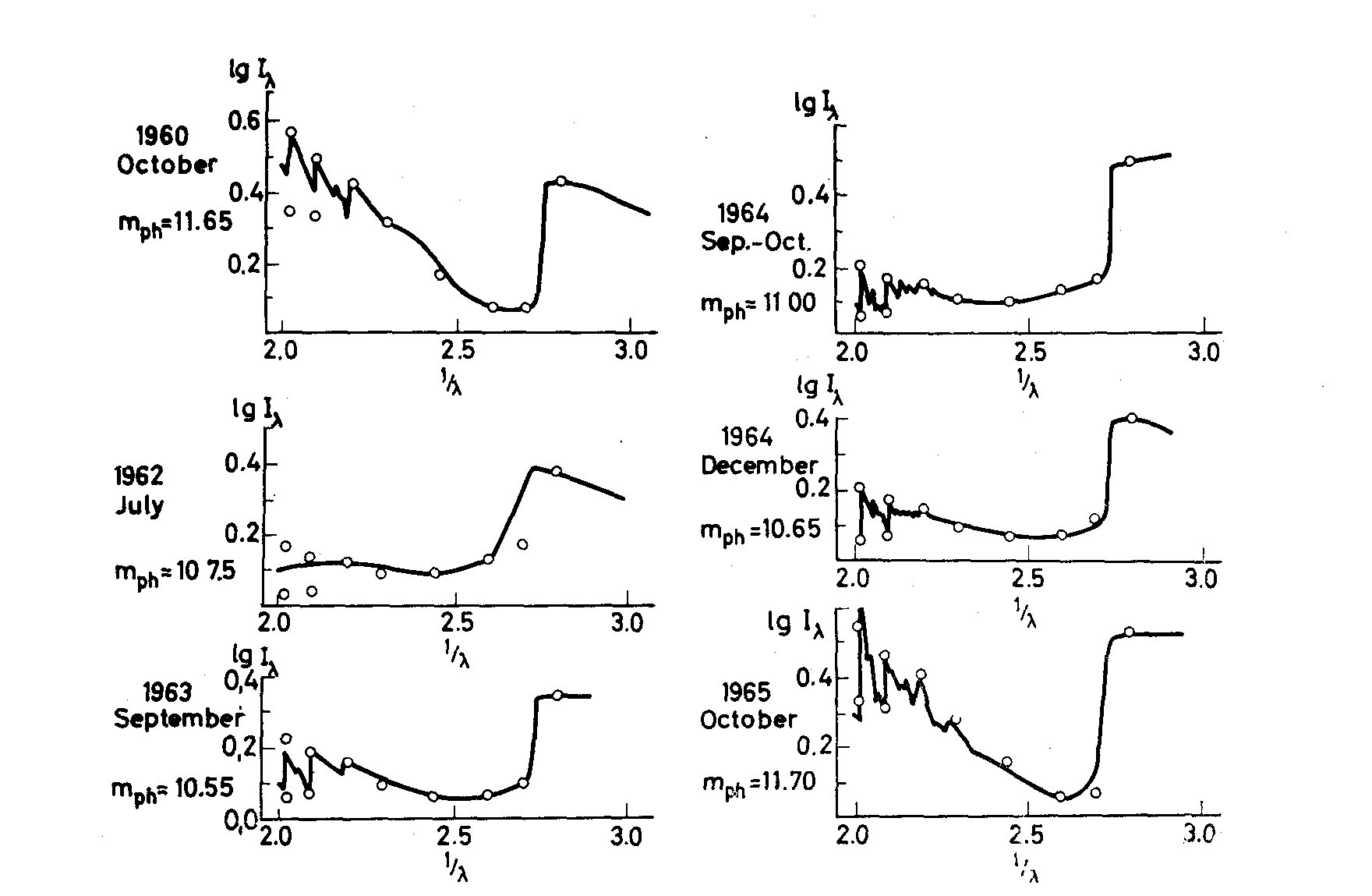 Fig. 11
The influence of a change of the excitation conditions on radial
velocities can especially be seen for Z And, Fig. 13 represents variations of
radial velocities determined from the ionized metal lines, A, and from the lines
of highly ionized elements, B. The symbol circle means that the star
had m_ph < 9m, X that 10m > m_ph > 9m and filled circle that m_ph > 10m.
The scattering is very large and is connected with change of stellar
brightness. Fig. 14 represents the dependence of the value of radial
velocity upon the magnitude of the star for phases 300d-400d.
Table 3.
V_r km/sec
Element 1915 1926 1939 1946 1952
H +16 +12 -4 -8 -27
HeI +6 +1 -8
NII +6 -12 -20
HeII -13 -6
NIII (-8) -20
OIII5007\ -17
4959/
OIII 4363 -55
FeII, TiII, SiII -22 -14 -18
Table 4
1960 1962 1963 1964 1964 1965
October July Sept. Sept.-Oct. December October
Z And 11.65 10.75 10.55 11.00 10.65 11.70
M2III 12.11 11.98 11.49 12.20 10.74 12.17
m_ph Nebula 14.00 13.25 12.90 12.86 12.78 13.68
Hot Comp. 13.29 11.34 11.37 11.77 11.47 13.50
T*10^-3 K 108 70 79 96 88 141
Hot Comp. M_v 2.82 1.07 1.57 1.32 1.55 3.05
R/R_Hel 0.30 0.70 0.55 0.60 0.54 0.26
lg n_e 7.1 7.3 7.5
Nebula M*10^-29 g 0.6 1.2 1.0 2.1 1.3 0.9
R*10^-15 cm 0.8 0.9 0.9 1.1 1.0 0.9
Fig. 11
The influence of a change of the excitation conditions on radial
velocities can especially be seen for Z And, Fig. 13 represents variations of
radial velocities determined from the ionized metal lines, A, and from the lines
of highly ionized elements, B. The symbol circle means that the star
had m_ph < 9m, X that 10m > m_ph > 9m and filled circle that m_ph > 10m.
The scattering is very large and is connected with change of stellar
brightness. Fig. 14 represents the dependence of the value of radial
velocity upon the magnitude of the star for phases 300d-400d.
Table 3.
V_r km/sec
Element 1915 1926 1939 1946 1952
H +16 +12 -4 -8 -27
HeI +6 +1 -8
NII +6 -12 -20
HeII -13 -6
NIII (-8) -20
OIII5007\ -17
4959/
OIII 4363 -55
FeII, TiII, SiII -22 -14 -18
Table 4
1960 1962 1963 1964 1964 1965
October July Sept. Sept.-Oct. December October
Z And 11.65 10.75 10.55 11.00 10.65 11.70
M2III 12.11 11.98 11.49 12.20 10.74 12.17
m_ph Nebula 14.00 13.25 12.90 12.86 12.78 13.68
Hot Comp. 13.29 11.34 11.37 11.77 11.47 13.50
T*10^-3 K 108 70 79 96 88 141
Hot Comp. M_v 2.82 1.07 1.57 1.32 1.55 3.05
R/R_Hel 0.30 0.70 0.55 0.60 0.54 0.26
lg n_e 7.1 7.3 7.5
Nebula M*10^-29 g 0.6 1.2 1.0 2.1 1.3 0.9
R*10^-15 cm 0.8 0.9 0.9 1.1 1.0 0.9
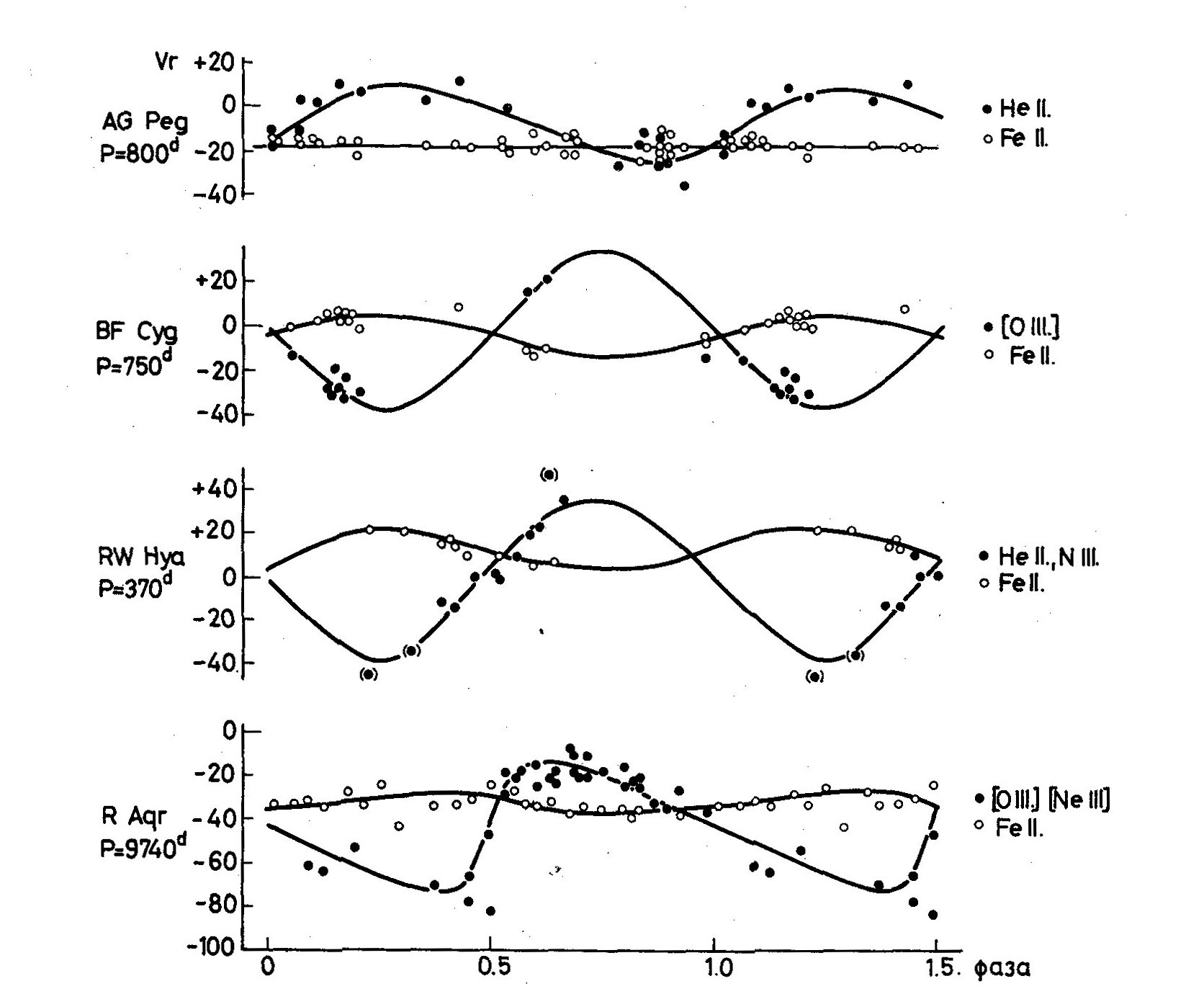 Fig. 12
Fig. 12
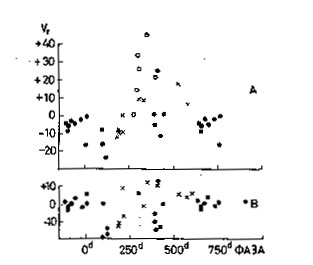 Fig. 13
Fig. 13
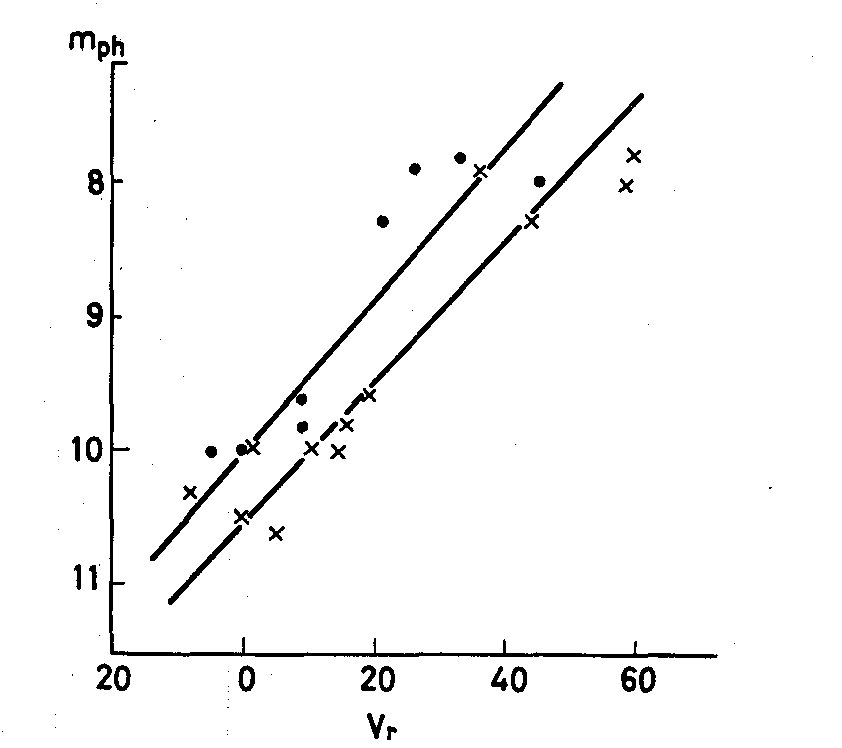 Fig. 14
The symbol o corresponds to FeII lines, the symbol x to hydrogen lines.
Thus, in the case of Z And, the radial velocity variations reflect the
variations of excitation conditions in a higher degree than an orbital motion.
Summing up the review of basic data about the variation of symbiotic
star characteristics, the conclusion should be drawn that non-periodic processes
take a very important place. Naturally the question arises which physical
process is responsible for these variations and what is its nature. Some
information about it can be obtained from an investigation of the continuous
spectra of symbiotic stars.
We will suppose that the continuous spectrum is formed by three sources
of energy (Boyarchuk 1967) I) an M-type giant, II) a hot component with
T ~ 10^5 K, III) a nebula with T_e ~ 17 000 K and n_e ~> 10^6 cm^-3.
The contributions of the three hypothetical sources of energy to the
combined spectrum of Z And are shown in Fig. 11 by the symbol o. The
agreement between the observed and theoretical distributions is quite
satisfactory. This comparison gives us a possibility to determine the
part of radiation contributed by each sources at any wave length for
different times.
These results together with the light curve of Z And give us a possibility
in turn to determine the brightness variation of each component. Table 4
contains some results. One can see that the brightness variations of the cool
component were negligible. On the contrary, the brightness variations of the
hot component were very large. They cause the brightness variations of Z And
on the whole. The temperature of the hot component which was determined
by Zanstra's modified method (Boyarchuk 1967b) changed significantly.
The temperature increased simultaneously with the increase of m_ph.
Such behaviour of the hot component is in good agreement with the observed
variations of the spectral and color characteristics of symbiotic stars. As it
follows from the calculations, the variations of the visible magnitude
of the hot component and of its temperature occur in such a way that the
bolometric luminosity does not change significantly. There are at least
two possibilities for the origin of such variations. First, the hot
component is affected by a pulsation. Second, an optically thick
envelope surrounding the hot component is formed as a result of mass
outflow from the cool component. We need further investigations for the
solution of this problem.
If we suppose that the cool components of symbiotic stars are normal
giants, then their hot components are located below the main sequence as
it can be seen from Fig. 15. The central stars of planetary nebulae, hot
components of SS Cyg-type stars, novae a.o. are located near this place
too. Perhaps the nonstability of all these objects has a common nature.
In conclusion we briefly consider the hypotheses for the nature of the
symbiotic stars. All hypotheses can be divided into three groups.
I. The symbiotic stars consist of a hot star surrounded by an optical
envelope. The cool absorption spectrum is formed in the outer part of
the envelope and the hot emission spectrum is formed in the inner part
of the envelope. This hypothesis was suggested by Sobolev (1945), Menzel
(1946) and Aller (1953). But many observations do not agree with this
hypothesis. For instance, the theory predicts that the relative
intensity of emission lines must have such disturbances as that in
the spectra of longperiod variables. But the observations have not
detected them.
Fig. 14
The symbol o corresponds to FeII lines, the symbol x to hydrogen lines.
Thus, in the case of Z And, the radial velocity variations reflect the
variations of excitation conditions in a higher degree than an orbital motion.
Summing up the review of basic data about the variation of symbiotic
star characteristics, the conclusion should be drawn that non-periodic processes
take a very important place. Naturally the question arises which physical
process is responsible for these variations and what is its nature. Some
information about it can be obtained from an investigation of the continuous
spectra of symbiotic stars.
We will suppose that the continuous spectrum is formed by three sources
of energy (Boyarchuk 1967) I) an M-type giant, II) a hot component with
T ~ 10^5 K, III) a nebula with T_e ~ 17 000 K and n_e ~> 10^6 cm^-3.
The contributions of the three hypothetical sources of energy to the
combined spectrum of Z And are shown in Fig. 11 by the symbol o. The
agreement between the observed and theoretical distributions is quite
satisfactory. This comparison gives us a possibility to determine the
part of radiation contributed by each sources at any wave length for
different times.
These results together with the light curve of Z And give us a possibility
in turn to determine the brightness variation of each component. Table 4
contains some results. One can see that the brightness variations of the cool
component were negligible. On the contrary, the brightness variations of the
hot component were very large. They cause the brightness variations of Z And
on the whole. The temperature of the hot component which was determined
by Zanstra's modified method (Boyarchuk 1967b) changed significantly.
The temperature increased simultaneously with the increase of m_ph.
Such behaviour of the hot component is in good agreement with the observed
variations of the spectral and color characteristics of symbiotic stars. As it
follows from the calculations, the variations of the visible magnitude
of the hot component and of its temperature occur in such a way that the
bolometric luminosity does not change significantly. There are at least
two possibilities for the origin of such variations. First, the hot
component is affected by a pulsation. Second, an optically thick
envelope surrounding the hot component is formed as a result of mass
outflow from the cool component. We need further investigations for the
solution of this problem.
If we suppose that the cool components of symbiotic stars are normal
giants, then their hot components are located below the main sequence as
it can be seen from Fig. 15. The central stars of planetary nebulae, hot
components of SS Cyg-type stars, novae a.o. are located near this place
too. Perhaps the nonstability of all these objects has a common nature.
In conclusion we briefly consider the hypotheses for the nature of the
symbiotic stars. All hypotheses can be divided into three groups.
I. The symbiotic stars consist of a hot star surrounded by an optical
envelope. The cool absorption spectrum is formed in the outer part of
the envelope and the hot emission spectrum is formed in the inner part
of the envelope. This hypothesis was suggested by Sobolev (1945), Menzel
(1946) and Aller (1953). But many observations do not agree with this
hypothesis. For instance, the theory predicts that the relative
intensity of emission lines must have such disturbances as that in
the spectra of longperiod variables. But the observations have not
detected them.
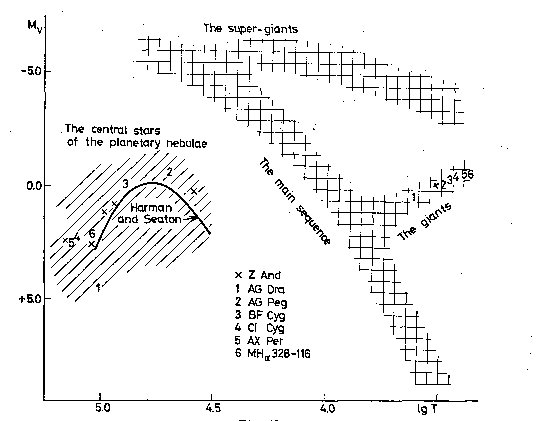 Fig. 15
Fig. 15
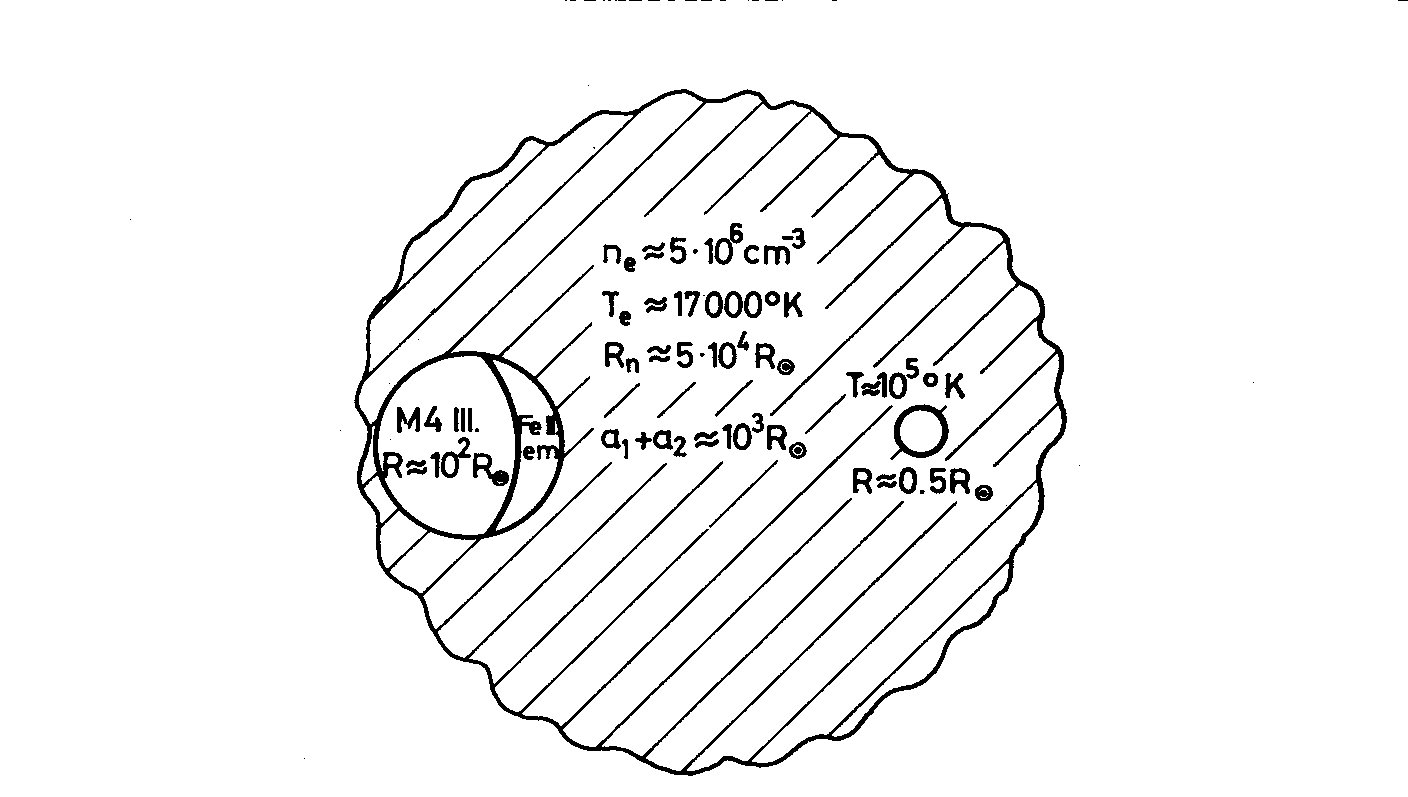 Fig. 16
II. A symbiotic star is a cool star with very extended dense corona
(Aller 1953, Gauzit 1955). Then the main difficulty is in the heating
problem. It is impossible to get such a large flux of mechanical energy
without heating the whole stellar photosphere.
III. The simplest hypothesis is that we are concerned with a binary, one
of the components is a late-type giant and the other one is a hot small
star being the source of the excitation of a nebula surrounding both
components. The hypothesis was first suggested by Hogg (1943) and then
by Swings and Struve (1941), Aller (1954), Sahade (1960) a.o.
The binary nature of symbiotic stars is confirmed by radial velocity
variations (see Fig. 12) and the light curve of AG Peg. All basic results of
observations can be explained from the point of view of binary hypothesis.
The quantitative investigations of symbiotic stars (Boyarchuk 1966,
1967) renders it possible to construct a rough hypothetical model of
symbiotic stars (see Fig 16). Of course, we need much more observations
and theoretical investigations to improve this model.
REFERENCES
Aller, L. H., 1954a, Astrophysics. New York.
Aller, L. H., 1954b, Publ. Dom. astrophys. Obs. 9., 321.
Belyakina, T. S., 1965, Izv. Krym. astrofiz. Obs. 33, 226.
Belyakina, T. S., 1966, Astrophys., 2, 115.
Belyakina, T. S., 1967, Izv. Krym astrofiz. Obs. 38, 171.
Belyakina, T. S., 1968, Astr. Zu. 45.
Bidelman, W. P., 1954, Astrophys. J. Suppl. 1, No. 7.
Bidelman, W. P., Stephenson, Ch. B., 1956, Publ. astr. Soc. Pacific 68, 152.
Bloch, M., 1964, Ann. Astrophys. 27, 292.
Boyarchuk, A. A., 1966, Astr. Zu. 43, 976.
Boyarchuk, A. A., 1967a, Astr. Zu. 44, 12.
Boyarchuk, A. A., 1967b, Astrophys. 3, 203.
Boyarchuk, A. A., 1967c, Astr. Zu. 44, 1016.
Boyarchuk, A. A., 1967d, Izv. Krym. astrofiz. Obs. 38, 155.
Boyarchuk, A. A., 1968a, Izv. Krym. astrofiz. Obs. 39, (in press).
Boyarchuk, A. A., 1968b, Astrophys. 4, (in press).
Elvey, C. T., 1941, Astrophys. J. 94, 140.
Erleksova, G. E., 1964, Bull. astrophys. Inst. of Acad. of Science of Tad. SSR, 37, 43.
Gauzit, J., 1955, Ann. Astrophys. 18, 354.
Greenstein, N. K., 1937, Harv. Obs. Bull. No. 906.
Henize, K. G., 1952, Astrophys. J. 115, 133.
Herbig, G. H., 1950, Publ. astr. Soc. Pacific, 62, 211.
Herbig, G. H., 1960, Astrophys. J. 131, 632.
Himpel, K., 1940, Astr. Nachr. 270, 184.
Himpel, K., 1942, Beob. Zirk. 24, 53.
Hoffleit, D., 1968, Irish. Astr. J. 8. 149.
Hogg, F. S., 1934, PAAS, 8, 14.
Ivanova, N. L., 1960, Soobsc. Byurak. Obs. 28, 17.
Jacchia, L., 1941, Harv. Obs. Bull. No. 912.
Lindsay, E. M., 1932, Harv. Obs. Bull. No. 888, 22.
Lundmark, K., 1921, Astr. Nachr. 113, 94.
Mayall, M., 1963, Quart, Bull. A. A. V. S. O. 20, 21, 23, 25.
Menzel, D., 1946, Physics, 12, 768.
Merrill, P. W., 1929, Astrophys. J. 69, 330.
Merrill, P. W., 1942, Astrophys. J. 95, 386.
Merrill, P. W., 1950a, Astrophys. J. 111, 484.
Merrill, P. W., 1950b, Astrophys. J. 112, 514.
Merrill, P. W., 1951a, Astrophys. J. 113, 605.
Merrill, P. W., 1951b, Astrophys. J. 114, 338.
Merrill, P. W., 1958, Etoiles a raies d'emission, Universite de Liege, p. 436.
Merrill, P. W., 1959, Astrophys. J. 129, 44.
O'Dell, C. R., 1966, Astrophys. J. 145, 487.
Payne-Gaposchkin, C., 1946, Astrophys. J. 104, 362.
Payne-Gaposchkin, C., 1950, Astrophys. J. 115.
Payne-Gaposchkin, C., 1957, The Galactic Novae, Amsterdam North-Holland Pub. Co.
Prager, R., 1941, Pop. Astr. 45, 445.
Romano, G., 1960, Publ. Osser. astr. Padova, 119.
Romano, G., 1966, Mem. Soc. astr. Ital. 37, N3.
Sahade, G., 1949, Astrophys. J. 109, 541.
Sahade, G., 1960, Stellar Atmospheres, J. L. Greenstein ed., Chicago p. 494.
Sahade, G., 1965, 3rd Colloquium on Variable Stars, Bamberg, p. 140.
Sandig, H. U., 1950, Astr. Nachr. 278, 187.
Sanford, R. F., 1944, Publ. astr. Soc. Pacific. 56, 122.
Sieder, Th., 1956, Mitt. veranderl. Sterne 238.
Sobolev, V. V., 1947, Moving Envelopes of Stars, Leningrad.
Sobolev, V. V., 1940, Astrophys. J. 91, 601.
Swings, P., Struve, O., 1941a, Astrophys. J. 93, 356.
Swings, P., Struve, O., 1941b, Astrophys. J. 94, 291.
Swings, P., Struve, O., 1942a, Astrophys. J. 95, 152.
Swings, P., Struve, O., 1942b, Astrophys. J. 96, 254.
Swings, P., Struve, O., 1943a, Astrophys. J. 97, 194.
Swings, P., Struve, O., 1943b, Astrophys. J. 98, 91.
Swope, H. H., 1940, Harv. Obs. Ann. 109, No. 1.
Tcheng Mao Lin, Bloch, M., 1952, Ann. Astrophys. 15, 104.
Tcheng Mao Lin, Bloch, M., 1954, Ann. Astrophys. 17, 6.
Thackeray, A. D., 1954, Observatory, 74, 257.
Tift, W. G. Greenstein, J. L., 1958, Astrophys. J. 127, 160.
Wachmann, A. A., 1961. Astr. Abhand. Hamburger Sternw. 4, No. 1.
Webster, L. B. 1966, Publ. astr. Soc. Pacific. 78, 136.
Wenzel, W., 1956. Mitt. Veranderl, Sterne 227.
Wilson, R. E. 1950. Publ. astr. Soc. Pacific 62, 14.
Fig. 16
II. A symbiotic star is a cool star with very extended dense corona
(Aller 1953, Gauzit 1955). Then the main difficulty is in the heating
problem. It is impossible to get such a large flux of mechanical energy
without heating the whole stellar photosphere.
III. The simplest hypothesis is that we are concerned with a binary, one
of the components is a late-type giant and the other one is a hot small
star being the source of the excitation of a nebula surrounding both
components. The hypothesis was first suggested by Hogg (1943) and then
by Swings and Struve (1941), Aller (1954), Sahade (1960) a.o.
The binary nature of symbiotic stars is confirmed by radial velocity
variations (see Fig. 12) and the light curve of AG Peg. All basic results of
observations can be explained from the point of view of binary hypothesis.
The quantitative investigations of symbiotic stars (Boyarchuk 1966,
1967) renders it possible to construct a rough hypothetical model of
symbiotic stars (see Fig 16). Of course, we need much more observations
and theoretical investigations to improve this model.
REFERENCES
Aller, L. H., 1954a, Astrophysics. New York.
Aller, L. H., 1954b, Publ. Dom. astrophys. Obs. 9., 321.
Belyakina, T. S., 1965, Izv. Krym. astrofiz. Obs. 33, 226.
Belyakina, T. S., 1966, Astrophys., 2, 115.
Belyakina, T. S., 1967, Izv. Krym astrofiz. Obs. 38, 171.
Belyakina, T. S., 1968, Astr. Zu. 45.
Bidelman, W. P., 1954, Astrophys. J. Suppl. 1, No. 7.
Bidelman, W. P., Stephenson, Ch. B., 1956, Publ. astr. Soc. Pacific 68, 152.
Bloch, M., 1964, Ann. Astrophys. 27, 292.
Boyarchuk, A. A., 1966, Astr. Zu. 43, 976.
Boyarchuk, A. A., 1967a, Astr. Zu. 44, 12.
Boyarchuk, A. A., 1967b, Astrophys. 3, 203.
Boyarchuk, A. A., 1967c, Astr. Zu. 44, 1016.
Boyarchuk, A. A., 1967d, Izv. Krym. astrofiz. Obs. 38, 155.
Boyarchuk, A. A., 1968a, Izv. Krym. astrofiz. Obs. 39, (in press).
Boyarchuk, A. A., 1968b, Astrophys. 4, (in press).
Elvey, C. T., 1941, Astrophys. J. 94, 140.
Erleksova, G. E., 1964, Bull. astrophys. Inst. of Acad. of Science of Tad. SSR, 37, 43.
Gauzit, J., 1955, Ann. Astrophys. 18, 354.
Greenstein, N. K., 1937, Harv. Obs. Bull. No. 906.
Henize, K. G., 1952, Astrophys. J. 115, 133.
Herbig, G. H., 1950, Publ. astr. Soc. Pacific, 62, 211.
Herbig, G. H., 1960, Astrophys. J. 131, 632.
Himpel, K., 1940, Astr. Nachr. 270, 184.
Himpel, K., 1942, Beob. Zirk. 24, 53.
Hoffleit, D., 1968, Irish. Astr. J. 8. 149.
Hogg, F. S., 1934, PAAS, 8, 14.
Ivanova, N. L., 1960, Soobsc. Byurak. Obs. 28, 17.
Jacchia, L., 1941, Harv. Obs. Bull. No. 912.
Lindsay, E. M., 1932, Harv. Obs. Bull. No. 888, 22.
Lundmark, K., 1921, Astr. Nachr. 113, 94.
Mayall, M., 1963, Quart, Bull. A. A. V. S. O. 20, 21, 23, 25.
Menzel, D., 1946, Physics, 12, 768.
Merrill, P. W., 1929, Astrophys. J. 69, 330.
Merrill, P. W., 1942, Astrophys. J. 95, 386.
Merrill, P. W., 1950a, Astrophys. J. 111, 484.
Merrill, P. W., 1950b, Astrophys. J. 112, 514.
Merrill, P. W., 1951a, Astrophys. J. 113, 605.
Merrill, P. W., 1951b, Astrophys. J. 114, 338.
Merrill, P. W., 1958, Etoiles a raies d'emission, Universite de Liege, p. 436.
Merrill, P. W., 1959, Astrophys. J. 129, 44.
O'Dell, C. R., 1966, Astrophys. J. 145, 487.
Payne-Gaposchkin, C., 1946, Astrophys. J. 104, 362.
Payne-Gaposchkin, C., 1950, Astrophys. J. 115.
Payne-Gaposchkin, C., 1957, The Galactic Novae, Amsterdam North-Holland Pub. Co.
Prager, R., 1941, Pop. Astr. 45, 445.
Romano, G., 1960, Publ. Osser. astr. Padova, 119.
Romano, G., 1966, Mem. Soc. astr. Ital. 37, N3.
Sahade, G., 1949, Astrophys. J. 109, 541.
Sahade, G., 1960, Stellar Atmospheres, J. L. Greenstein ed., Chicago p. 494.
Sahade, G., 1965, 3rd Colloquium on Variable Stars, Bamberg, p. 140.
Sandig, H. U., 1950, Astr. Nachr. 278, 187.
Sanford, R. F., 1944, Publ. astr. Soc. Pacific. 56, 122.
Sieder, Th., 1956, Mitt. veranderl. Sterne 238.
Sobolev, V. V., 1947, Moving Envelopes of Stars, Leningrad.
Sobolev, V. V., 1940, Astrophys. J. 91, 601.
Swings, P., Struve, O., 1941a, Astrophys. J. 93, 356.
Swings, P., Struve, O., 1941b, Astrophys. J. 94, 291.
Swings, P., Struve, O., 1942a, Astrophys. J. 95, 152.
Swings, P., Struve, O., 1942b, Astrophys. J. 96, 254.
Swings, P., Struve, O., 1943a, Astrophys. J. 97, 194.
Swings, P., Struve, O., 1943b, Astrophys. J. 98, 91.
Swope, H. H., 1940, Harv. Obs. Ann. 109, No. 1.
Tcheng Mao Lin, Bloch, M., 1952, Ann. Astrophys. 15, 104.
Tcheng Mao Lin, Bloch, M., 1954, Ann. Astrophys. 17, 6.
Thackeray, A. D., 1954, Observatory, 74, 257.
Tift, W. G. Greenstein, J. L., 1958, Astrophys. J. 127, 160.
Wachmann, A. A., 1961. Astr. Abhand. Hamburger Sternw. 4, No. 1.
Webster, L. B. 1966, Publ. astr. Soc. Pacific. 78, 136.
Wenzel, W., 1956. Mitt. Veranderl, Sterne 227.
Wilson, R. E. 1950. Publ. astr. Soc. Pacific 62, 14.
 Fig. 1
Fig. 1
 Fig. 2
Fig. 3 shows the light curve of CI Cyg, which was constructed on the
basis of papers by Greenstein (1937), Aller (1954) and Hoffleit (1968).
The brightness of the star varied generally with small amplitude. Rather
large flares were observed only twice, in 1911 and in 1958. Mrs. Hoffleit
has found that quasi-periodic variations have a period of 815^d.
We can see the form of those variations in Fig. 4, which was adopted
from Hoffleit's paper (1968). The scattering on that figure is large. It
means that non-periodic variations are important.
Fig. 5 shows the light curve of AX Per, which was constructed on the
basis of papers by Lindsay (1932), Payne-Gaposchkin (1946), Wenzel (1956),
Sieder (1956) and Romano (1960). On the whole the light variations of AX Per
are similar to those of Z And.
The light variations of AG Peg have different character. Fig. 6 shows
the light curve of AG Peg from 1825 on. The symbols are as follow
filled circle-m_vis, X-m_ph, triangle-u, square-B, circle-V.
The original data were published by Lundmark (1921), Himpel (1942),
Sandig (1950), Payne-Gaposchkin (1950), Mayall (1964) and Belyakina (1965).
In general terms the light curve of AG Peg resembles that of a slow
developed flare. Using more detailed observations in the last years
(Mayall, 1964, Belyakina, 1965) Miss Belyakina discovered the periodical
variation of brightness with P = 800^d and Delta m ~ 0.3m. This is easy to see
in Fig. 7. The symbols are: circle-visual, filled circle-photoelectric V.
Special photoelectric observations of the light variation of symbiotic
stars (Belyakina 1965, 1967) have shown, that many of them show rapid light
variations with small amplitudes and such variations have a non-periodic
character. Some examples are shown in Fig. 8 (Z And) and in Fig. 9 (AG Dra).
In these figures the dots correspond to brightness differences between the
symbiotic star and the comparison stars, and the crosses correspond to those
between two standard stars. The largest short-time variations have been
observed in the ultraviolet.
Fig. 2
Fig. 3 shows the light curve of CI Cyg, which was constructed on the
basis of papers by Greenstein (1937), Aller (1954) and Hoffleit (1968).
The brightness of the star varied generally with small amplitude. Rather
large flares were observed only twice, in 1911 and in 1958. Mrs. Hoffleit
has found that quasi-periodic variations have a period of 815^d.
We can see the form of those variations in Fig. 4, which was adopted
from Hoffleit's paper (1968). The scattering on that figure is large. It
means that non-periodic variations are important.
Fig. 5 shows the light curve of AX Per, which was constructed on the
basis of papers by Lindsay (1932), Payne-Gaposchkin (1946), Wenzel (1956),
Sieder (1956) and Romano (1960). On the whole the light variations of AX Per
are similar to those of Z And.
The light variations of AG Peg have different character. Fig. 6 shows
the light curve of AG Peg from 1825 on. The symbols are as follow
filled circle-m_vis, X-m_ph, triangle-u, square-B, circle-V.
The original data were published by Lundmark (1921), Himpel (1942),
Sandig (1950), Payne-Gaposchkin (1950), Mayall (1964) and Belyakina (1965).
In general terms the light curve of AG Peg resembles that of a slow
developed flare. Using more detailed observations in the last years
(Mayall, 1964, Belyakina, 1965) Miss Belyakina discovered the periodical
variation of brightness with P = 800^d and Delta m ~ 0.3m. This is easy to see
in Fig. 7. The symbols are: circle-visual, filled circle-photoelectric V.
Special photoelectric observations of the light variation of symbiotic
stars (Belyakina 1965, 1967) have shown, that many of them show rapid light
variations with small amplitudes and such variations have a non-periodic
character. Some examples are shown in Fig. 8 (Z And) and in Fig. 9 (AG Dra).
In these figures the dots correspond to brightness differences between the
symbiotic star and the comparison stars, and the crosses correspond to those
between two standard stars. The largest short-time variations have been
observed in the ultraviolet.
 Fig. 3
Fig. 3
 Fig. 4
Fig. 4
 Fig. 5
Thus the available observations show that non-periodic processes play a
very important role in the light variation of symbiotic stars.
The brightness variations of symbiotic stars are accompanied by color
variations. As it was noted by Jacchia (1941), Himpel (1941), Payne-Gaposchkin
(1946) and al., the value m_ph-m_v increases with decreasing brightness,
i.e. star becomes redder. Belyakina's photoelectric observations confirm this
statement, moreover, she has shown, that the U-B color decreases with
decreasing stellar brightness, i.e. the ultraviolet excess increases.
Fig. 5
Thus the available observations show that non-periodic processes play a
very important role in the light variation of symbiotic stars.
The brightness variations of symbiotic stars are accompanied by color
variations. As it was noted by Jacchia (1941), Himpel (1941), Payne-Gaposchkin
(1946) and al., the value m_ph-m_v increases with decreasing brightness,
i.e. star becomes redder. Belyakina's photoelectric observations confirm this
statement, moreover, she has shown, that the U-B color decreases with
decreasing stellar brightness, i.e. the ultraviolet excess increases.
 Fig. 6
Fig. 6
 Fig. 7
Fig. 7
 Fig. 8
Fig. 8
 Fig. 9
SPECTRAL VARIATIONS
The character of spectra of symbiotic stars also changes together with
the light variations. Already in 1934 Hogg (1934) noted that features of
a late type spectrum strengthened when the brightness of Z And decreased.
At the same time the excitation degree of the emission spectrum increased.
Later similar changes of the spectrum were found for other symbiotic
stars.
Fig. 10 shows the intensity tracing of spectra of AX Per taken in 1964,
at m_ph = 13.5m, and in 1965, at m_ph = 12.8m. We can see that the intensities
of the [FeVII] and He II lines appreciably decreased in comparison with those
of hydrogen when the stellar brightness increased by 1 mag. At the same time
the intensity of the TiO bands strongly decreased.
Swings and Struve (1941a) have recognized that during the large flare of
Z And in 1939 its spectrum underwent great changes. Late-type absorption
features as well as highly excited emission lines disappeared
completely. But absorption lines usually observed in the spectra of
A0-A2 type stars were seen in the spectra of Z And. The hydrogen and
neutral helium emission lines had absorption companions. At that time
the spectrum of Z And was very similar to that of P Cyg type stars.
According to Miss Bloch (1964) such changes were also observed during
the large flare in 1961. Similar changes took place in the spectrum of
AX Per during a flare in 1955 (Gauzit 1955). Unfortunately, the number
of spectral observations of symbiotic stars is much less than those of
the brightness, and we can only suppose that during large flares of
other symbiotic stars similar changes took place in the spectra.
Fig. 9
SPECTRAL VARIATIONS
The character of spectra of symbiotic stars also changes together with
the light variations. Already in 1934 Hogg (1934) noted that features of
a late type spectrum strengthened when the brightness of Z And decreased.
At the same time the excitation degree of the emission spectrum increased.
Later similar changes of the spectrum were found for other symbiotic
stars.
Fig. 10 shows the intensity tracing of spectra of AX Per taken in 1964,
at m_ph = 13.5m, and in 1965, at m_ph = 12.8m. We can see that the intensities
of the [FeVII] and He II lines appreciably decreased in comparison with those
of hydrogen when the stellar brightness increased by 1 mag. At the same time
the intensity of the TiO bands strongly decreased.
Swings and Struve (1941a) have recognized that during the large flare of
Z And in 1939 its spectrum underwent great changes. Late-type absorption
features as well as highly excited emission lines disappeared
completely. But absorption lines usually observed in the spectra of
A0-A2 type stars were seen in the spectra of Z And. The hydrogen and
neutral helium emission lines had absorption companions. At that time
the spectrum of Z And was very similar to that of P Cyg type stars.
According to Miss Bloch (1964) such changes were also observed during
the large flare in 1961. Similar changes took place in the spectrum of
AX Per during a flare in 1955 (Gauzit 1955). Unfortunately, the number
of spectral observations of symbiotic stars is much less than those of
the brightness, and we can only suppose that during large flares of
other symbiotic stars similar changes took place in the spectra.
 Fig. 10
The energy distribution in the continuous spectra of symbiotic stars
has been investigated by many authors (Tcheng Mao Lin, Bloch 1952, 1954,
Ivanova 1960, Boyarchuk 1967 and al.). The results of these investigations
are in good agreement with those of color variation. In Fig. 11 the solid
lines represent the observed energy distribution in the spectrum of Z And for
different data. It is seen that the energy distribution becomes steeper and
the Balmer jump increases when the star becomes fainter.
The displacement of different lines, or the radial velocities can give
important informations about the processes in symbiotic stars. At present a
rather large number of measurements of radial velocities for five stars:
AG Peg, BF Cyg, Z And, RW Hya and R Aqr have been published mainly by Merrill
and by Swings and Struve (1941-1943). The variations of radial velocities have
periodic character for four stars: AG Peg, BF Cyg, RW Hya and R Aqr.
The velocity curves of the stars mentioned are represented in Fig. 12. This
figure brings into evidence the binary nature of symbiotic stars. It should
be noted that AG Peg shows progressive changes of radial velocity as well as
periodic variations. Table 3, which was compiled by using Merrill's data (1929,
1942, 1951a, b, 1959) contains data about the average velocities
determined from the displacements of different lines. Boyarchuk (1967)
has explained this phenomenon by the decreasing opacity of an envelope
and by the changing excitation conditions.
Fig. 10
The energy distribution in the continuous spectra of symbiotic stars
has been investigated by many authors (Tcheng Mao Lin, Bloch 1952, 1954,
Ivanova 1960, Boyarchuk 1967 and al.). The results of these investigations
are in good agreement with those of color variation. In Fig. 11 the solid
lines represent the observed energy distribution in the spectrum of Z And for
different data. It is seen that the energy distribution becomes steeper and
the Balmer jump increases when the star becomes fainter.
The displacement of different lines, or the radial velocities can give
important informations about the processes in symbiotic stars. At present a
rather large number of measurements of radial velocities for five stars:
AG Peg, BF Cyg, Z And, RW Hya and R Aqr have been published mainly by Merrill
and by Swings and Struve (1941-1943). The variations of radial velocities have
periodic character for four stars: AG Peg, BF Cyg, RW Hya and R Aqr.
The velocity curves of the stars mentioned are represented in Fig. 12. This
figure brings into evidence the binary nature of symbiotic stars. It should
be noted that AG Peg shows progressive changes of radial velocity as well as
periodic variations. Table 3, which was compiled by using Merrill's data (1929,
1942, 1951a, b, 1959) contains data about the average velocities
determined from the displacements of different lines. Boyarchuk (1967)
has explained this phenomenon by the decreasing opacity of an envelope
and by the changing excitation conditions.
 Fig. 11
The influence of a change of the excitation conditions on radial
velocities can especially be seen for Z And, Fig. 13 represents variations of
radial velocities determined from the ionized metal lines, A, and from the lines
of highly ionized elements, B. The symbol circle means that the star
had m_ph < 9m, X that 10m > m_ph > 9m and filled circle that m_ph > 10m.
The scattering is very large and is connected with change of stellar
brightness. Fig. 14 represents the dependence of the value of radial
velocity upon the magnitude of the star for phases 300d-400d.
Table 3.
V_r km/sec
Element 1915 1926 1939 1946 1952
H +16 +12 -4 -8 -27
HeI +6 +1 -8
NII +6 -12 -20
HeII -13 -6
NIII (-8) -20
OIII5007\ -17
4959/
OIII 4363 -55
FeII, TiII, SiII -22 -14 -18
Table 4
1960 1962 1963 1964 1964 1965
October July Sept. Sept.-Oct. December October
Z And 11.65 10.75 10.55 11.00 10.65 11.70
M2III 12.11 11.98 11.49 12.20 10.74 12.17
m_ph Nebula 14.00 13.25 12.90 12.86 12.78 13.68
Hot Comp. 13.29 11.34 11.37 11.77 11.47 13.50
T*10^-3 K 108 70 79 96 88 141
Hot Comp. M_v 2.82 1.07 1.57 1.32 1.55 3.05
R/R_Hel 0.30 0.70 0.55 0.60 0.54 0.26
lg n_e 7.1 7.3 7.5
Nebula M*10^-29 g 0.6 1.2 1.0 2.1 1.3 0.9
R*10^-15 cm 0.8 0.9 0.9 1.1 1.0 0.9
Fig. 11
The influence of a change of the excitation conditions on radial
velocities can especially be seen for Z And, Fig. 13 represents variations of
radial velocities determined from the ionized metal lines, A, and from the lines
of highly ionized elements, B. The symbol circle means that the star
had m_ph < 9m, X that 10m > m_ph > 9m and filled circle that m_ph > 10m.
The scattering is very large and is connected with change of stellar
brightness. Fig. 14 represents the dependence of the value of radial
velocity upon the magnitude of the star for phases 300d-400d.
Table 3.
V_r km/sec
Element 1915 1926 1939 1946 1952
H +16 +12 -4 -8 -27
HeI +6 +1 -8
NII +6 -12 -20
HeII -13 -6
NIII (-8) -20
OIII5007\ -17
4959/
OIII 4363 -55
FeII, TiII, SiII -22 -14 -18
Table 4
1960 1962 1963 1964 1964 1965
October July Sept. Sept.-Oct. December October
Z And 11.65 10.75 10.55 11.00 10.65 11.70
M2III 12.11 11.98 11.49 12.20 10.74 12.17
m_ph Nebula 14.00 13.25 12.90 12.86 12.78 13.68
Hot Comp. 13.29 11.34 11.37 11.77 11.47 13.50
T*10^-3 K 108 70 79 96 88 141
Hot Comp. M_v 2.82 1.07 1.57 1.32 1.55 3.05
R/R_Hel 0.30 0.70 0.55 0.60 0.54 0.26
lg n_e 7.1 7.3 7.5
Nebula M*10^-29 g 0.6 1.2 1.0 2.1 1.3 0.9
R*10^-15 cm 0.8 0.9 0.9 1.1 1.0 0.9
 Fig. 12
Fig. 12
 Fig. 13
Fig. 13
 Fig. 14
The symbol o corresponds to FeII lines, the symbol x to hydrogen lines.
Thus, in the case of Z And, the radial velocity variations reflect the
variations of excitation conditions in a higher degree than an orbital motion.
Summing up the review of basic data about the variation of symbiotic
star characteristics, the conclusion should be drawn that non-periodic processes
take a very important place. Naturally the question arises which physical
process is responsible for these variations and what is its nature. Some
information about it can be obtained from an investigation of the continuous
spectra of symbiotic stars.
We will suppose that the continuous spectrum is formed by three sources
of energy (Boyarchuk 1967) I) an M-type giant, II) a hot component with
T ~ 10^5 K, III) a nebula with T_e ~ 17 000 K and n_e ~> 10^6 cm^-3.
The contributions of the three hypothetical sources of energy to the
combined spectrum of Z And are shown in Fig. 11 by the symbol o. The
agreement between the observed and theoretical distributions is quite
satisfactory. This comparison gives us a possibility to determine the
part of radiation contributed by each sources at any wave length for
different times.
These results together with the light curve of Z And give us a possibility
in turn to determine the brightness variation of each component. Table 4
contains some results. One can see that the brightness variations of the cool
component were negligible. On the contrary, the brightness variations of the
hot component were very large. They cause the brightness variations of Z And
on the whole. The temperature of the hot component which was determined
by Zanstra's modified method (Boyarchuk 1967b) changed significantly.
The temperature increased simultaneously with the increase of m_ph.
Such behaviour of the hot component is in good agreement with the observed
variations of the spectral and color characteristics of symbiotic stars. As it
follows from the calculations, the variations of the visible magnitude
of the hot component and of its temperature occur in such a way that the
bolometric luminosity does not change significantly. There are at least
two possibilities for the origin of such variations. First, the hot
component is affected by a pulsation. Second, an optically thick
envelope surrounding the hot component is formed as a result of mass
outflow from the cool component. We need further investigations for the
solution of this problem.
If we suppose that the cool components of symbiotic stars are normal
giants, then their hot components are located below the main sequence as
it can be seen from Fig. 15. The central stars of planetary nebulae, hot
components of SS Cyg-type stars, novae a.o. are located near this place
too. Perhaps the nonstability of all these objects has a common nature.
In conclusion we briefly consider the hypotheses for the nature of the
symbiotic stars. All hypotheses can be divided into three groups.
I. The symbiotic stars consist of a hot star surrounded by an optical
envelope. The cool absorption spectrum is formed in the outer part of
the envelope and the hot emission spectrum is formed in the inner part
of the envelope. This hypothesis was suggested by Sobolev (1945), Menzel
(1946) and Aller (1953). But many observations do not agree with this
hypothesis. For instance, the theory predicts that the relative
intensity of emission lines must have such disturbances as that in
the spectra of longperiod variables. But the observations have not
detected them.
Fig. 14
The symbol o corresponds to FeII lines, the symbol x to hydrogen lines.
Thus, in the case of Z And, the radial velocity variations reflect the
variations of excitation conditions in a higher degree than an orbital motion.
Summing up the review of basic data about the variation of symbiotic
star characteristics, the conclusion should be drawn that non-periodic processes
take a very important place. Naturally the question arises which physical
process is responsible for these variations and what is its nature. Some
information about it can be obtained from an investigation of the continuous
spectra of symbiotic stars.
We will suppose that the continuous spectrum is formed by three sources
of energy (Boyarchuk 1967) I) an M-type giant, II) a hot component with
T ~ 10^5 K, III) a nebula with T_e ~ 17 000 K and n_e ~> 10^6 cm^-3.
The contributions of the three hypothetical sources of energy to the
combined spectrum of Z And are shown in Fig. 11 by the symbol o. The
agreement between the observed and theoretical distributions is quite
satisfactory. This comparison gives us a possibility to determine the
part of radiation contributed by each sources at any wave length for
different times.
These results together with the light curve of Z And give us a possibility
in turn to determine the brightness variation of each component. Table 4
contains some results. One can see that the brightness variations of the cool
component were negligible. On the contrary, the brightness variations of the
hot component were very large. They cause the brightness variations of Z And
on the whole. The temperature of the hot component which was determined
by Zanstra's modified method (Boyarchuk 1967b) changed significantly.
The temperature increased simultaneously with the increase of m_ph.
Such behaviour of the hot component is in good agreement with the observed
variations of the spectral and color characteristics of symbiotic stars. As it
follows from the calculations, the variations of the visible magnitude
of the hot component and of its temperature occur in such a way that the
bolometric luminosity does not change significantly. There are at least
two possibilities for the origin of such variations. First, the hot
component is affected by a pulsation. Second, an optically thick
envelope surrounding the hot component is formed as a result of mass
outflow from the cool component. We need further investigations for the
solution of this problem.
If we suppose that the cool components of symbiotic stars are normal
giants, then their hot components are located below the main sequence as
it can be seen from Fig. 15. The central stars of planetary nebulae, hot
components of SS Cyg-type stars, novae a.o. are located near this place
too. Perhaps the nonstability of all these objects has a common nature.
In conclusion we briefly consider the hypotheses for the nature of the
symbiotic stars. All hypotheses can be divided into three groups.
I. The symbiotic stars consist of a hot star surrounded by an optical
envelope. The cool absorption spectrum is formed in the outer part of
the envelope and the hot emission spectrum is formed in the inner part
of the envelope. This hypothesis was suggested by Sobolev (1945), Menzel
(1946) and Aller (1953). But many observations do not agree with this
hypothesis. For instance, the theory predicts that the relative
intensity of emission lines must have such disturbances as that in
the spectra of longperiod variables. But the observations have not
detected them.
 Fig. 15
Fig. 15
 Fig. 16
II. A symbiotic star is a cool star with very extended dense corona
(Aller 1953, Gauzit 1955). Then the main difficulty is in the heating
problem. It is impossible to get such a large flux of mechanical energy
without heating the whole stellar photosphere.
III. The simplest hypothesis is that we are concerned with a binary, one
of the components is a late-type giant and the other one is a hot small
star being the source of the excitation of a nebula surrounding both
components. The hypothesis was first suggested by Hogg (1943) and then
by Swings and Struve (1941), Aller (1954), Sahade (1960) a.o.
The binary nature of symbiotic stars is confirmed by radial velocity
variations (see Fig. 12) and the light curve of AG Peg. All basic results of
observations can be explained from the point of view of binary hypothesis.
The quantitative investigations of symbiotic stars (Boyarchuk 1966,
1967) renders it possible to construct a rough hypothetical model of
symbiotic stars (see Fig 16). Of course, we need much more observations
and theoretical investigations to improve this model.
REFERENCES
Aller, L. H., 1954a, Astrophysics. New York.
Aller, L. H., 1954b, Publ. Dom. astrophys. Obs. 9., 321.
Belyakina, T. S., 1965, Izv. Krym. astrofiz. Obs. 33, 226.
Belyakina, T. S., 1966, Astrophys., 2, 115.
Belyakina, T. S., 1967, Izv. Krym astrofiz. Obs. 38, 171.
Belyakina, T. S., 1968, Astr. Zu. 45.
Bidelman, W. P., 1954, Astrophys. J. Suppl. 1, No. 7.
Bidelman, W. P., Stephenson, Ch. B., 1956, Publ. astr. Soc. Pacific 68, 152.
Bloch, M., 1964, Ann. Astrophys. 27, 292.
Boyarchuk, A. A., 1966, Astr. Zu. 43, 976.
Boyarchuk, A. A., 1967a, Astr. Zu. 44, 12.
Boyarchuk, A. A., 1967b, Astrophys. 3, 203.
Boyarchuk, A. A., 1967c, Astr. Zu. 44, 1016.
Boyarchuk, A. A., 1967d, Izv. Krym. astrofiz. Obs. 38, 155.
Boyarchuk, A. A., 1968a, Izv. Krym. astrofiz. Obs. 39, (in press).
Boyarchuk, A. A., 1968b, Astrophys. 4, (in press).
Elvey, C. T., 1941, Astrophys. J. 94, 140.
Erleksova, G. E., 1964, Bull. astrophys. Inst. of Acad. of Science of Tad. SSR, 37, 43.
Gauzit, J., 1955, Ann. Astrophys. 18, 354.
Greenstein, N. K., 1937, Harv. Obs. Bull. No. 906.
Henize, K. G., 1952, Astrophys. J. 115, 133.
Herbig, G. H., 1950, Publ. astr. Soc. Pacific, 62, 211.
Herbig, G. H., 1960, Astrophys. J. 131, 632.
Himpel, K., 1940, Astr. Nachr. 270, 184.
Himpel, K., 1942, Beob. Zirk. 24, 53.
Hoffleit, D., 1968, Irish. Astr. J. 8. 149.
Hogg, F. S., 1934, PAAS, 8, 14.
Ivanova, N. L., 1960, Soobsc. Byurak. Obs. 28, 17.
Jacchia, L., 1941, Harv. Obs. Bull. No. 912.
Lindsay, E. M., 1932, Harv. Obs. Bull. No. 888, 22.
Lundmark, K., 1921, Astr. Nachr. 113, 94.
Mayall, M., 1963, Quart, Bull. A. A. V. S. O. 20, 21, 23, 25.
Menzel, D., 1946, Physics, 12, 768.
Merrill, P. W., 1929, Astrophys. J. 69, 330.
Merrill, P. W., 1942, Astrophys. J. 95, 386.
Merrill, P. W., 1950a, Astrophys. J. 111, 484.
Merrill, P. W., 1950b, Astrophys. J. 112, 514.
Merrill, P. W., 1951a, Astrophys. J. 113, 605.
Merrill, P. W., 1951b, Astrophys. J. 114, 338.
Merrill, P. W., 1958, Etoiles a raies d'emission, Universite de Liege, p. 436.
Merrill, P. W., 1959, Astrophys. J. 129, 44.
O'Dell, C. R., 1966, Astrophys. J. 145, 487.
Payne-Gaposchkin, C., 1946, Astrophys. J. 104, 362.
Payne-Gaposchkin, C., 1950, Astrophys. J. 115.
Payne-Gaposchkin, C., 1957, The Galactic Novae, Amsterdam North-Holland Pub. Co.
Prager, R., 1941, Pop. Astr. 45, 445.
Romano, G., 1960, Publ. Osser. astr. Padova, 119.
Romano, G., 1966, Mem. Soc. astr. Ital. 37, N3.
Sahade, G., 1949, Astrophys. J. 109, 541.
Sahade, G., 1960, Stellar Atmospheres, J. L. Greenstein ed., Chicago p. 494.
Sahade, G., 1965, 3rd Colloquium on Variable Stars, Bamberg, p. 140.
Sandig, H. U., 1950, Astr. Nachr. 278, 187.
Sanford, R. F., 1944, Publ. astr. Soc. Pacific. 56, 122.
Sieder, Th., 1956, Mitt. veranderl. Sterne 238.
Sobolev, V. V., 1947, Moving Envelopes of Stars, Leningrad.
Sobolev, V. V., 1940, Astrophys. J. 91, 601.
Swings, P., Struve, O., 1941a, Astrophys. J. 93, 356.
Swings, P., Struve, O., 1941b, Astrophys. J. 94, 291.
Swings, P., Struve, O., 1942a, Astrophys. J. 95, 152.
Swings, P., Struve, O., 1942b, Astrophys. J. 96, 254.
Swings, P., Struve, O., 1943a, Astrophys. J. 97, 194.
Swings, P., Struve, O., 1943b, Astrophys. J. 98, 91.
Swope, H. H., 1940, Harv. Obs. Ann. 109, No. 1.
Tcheng Mao Lin, Bloch, M., 1952, Ann. Astrophys. 15, 104.
Tcheng Mao Lin, Bloch, M., 1954, Ann. Astrophys. 17, 6.
Thackeray, A. D., 1954, Observatory, 74, 257.
Tift, W. G. Greenstein, J. L., 1958, Astrophys. J. 127, 160.
Wachmann, A. A., 1961. Astr. Abhand. Hamburger Sternw. 4, No. 1.
Webster, L. B. 1966, Publ. astr. Soc. Pacific. 78, 136.
Wenzel, W., 1956. Mitt. Veranderl, Sterne 227.
Wilson, R. E. 1950. Publ. astr. Soc. Pacific 62, 14.
Fig. 16
II. A symbiotic star is a cool star with very extended dense corona
(Aller 1953, Gauzit 1955). Then the main difficulty is in the heating
problem. It is impossible to get such a large flux of mechanical energy
without heating the whole stellar photosphere.
III. The simplest hypothesis is that we are concerned with a binary, one
of the components is a late-type giant and the other one is a hot small
star being the source of the excitation of a nebula surrounding both
components. The hypothesis was first suggested by Hogg (1943) and then
by Swings and Struve (1941), Aller (1954), Sahade (1960) a.o.
The binary nature of symbiotic stars is confirmed by radial velocity
variations (see Fig. 12) and the light curve of AG Peg. All basic results of
observations can be explained from the point of view of binary hypothesis.
The quantitative investigations of symbiotic stars (Boyarchuk 1966,
1967) renders it possible to construct a rough hypothetical model of
symbiotic stars (see Fig 16). Of course, we need much more observations
and theoretical investigations to improve this model.
REFERENCES
Aller, L. H., 1954a, Astrophysics. New York.
Aller, L. H., 1954b, Publ. Dom. astrophys. Obs. 9., 321.
Belyakina, T. S., 1965, Izv. Krym. astrofiz. Obs. 33, 226.
Belyakina, T. S., 1966, Astrophys., 2, 115.
Belyakina, T. S., 1967, Izv. Krym astrofiz. Obs. 38, 171.
Belyakina, T. S., 1968, Astr. Zu. 45.
Bidelman, W. P., 1954, Astrophys. J. Suppl. 1, No. 7.
Bidelman, W. P., Stephenson, Ch. B., 1956, Publ. astr. Soc. Pacific 68, 152.
Bloch, M., 1964, Ann. Astrophys. 27, 292.
Boyarchuk, A. A., 1966, Astr. Zu. 43, 976.
Boyarchuk, A. A., 1967a, Astr. Zu. 44, 12.
Boyarchuk, A. A., 1967b, Astrophys. 3, 203.
Boyarchuk, A. A., 1967c, Astr. Zu. 44, 1016.
Boyarchuk, A. A., 1967d, Izv. Krym. astrofiz. Obs. 38, 155.
Boyarchuk, A. A., 1968a, Izv. Krym. astrofiz. Obs. 39, (in press).
Boyarchuk, A. A., 1968b, Astrophys. 4, (in press).
Elvey, C. T., 1941, Astrophys. J. 94, 140.
Erleksova, G. E., 1964, Bull. astrophys. Inst. of Acad. of Science of Tad. SSR, 37, 43.
Gauzit, J., 1955, Ann. Astrophys. 18, 354.
Greenstein, N. K., 1937, Harv. Obs. Bull. No. 906.
Henize, K. G., 1952, Astrophys. J. 115, 133.
Herbig, G. H., 1950, Publ. astr. Soc. Pacific, 62, 211.
Herbig, G. H., 1960, Astrophys. J. 131, 632.
Himpel, K., 1940, Astr. Nachr. 270, 184.
Himpel, K., 1942, Beob. Zirk. 24, 53.
Hoffleit, D., 1968, Irish. Astr. J. 8. 149.
Hogg, F. S., 1934, PAAS, 8, 14.
Ivanova, N. L., 1960, Soobsc. Byurak. Obs. 28, 17.
Jacchia, L., 1941, Harv. Obs. Bull. No. 912.
Lindsay, E. M., 1932, Harv. Obs. Bull. No. 888, 22.
Lundmark, K., 1921, Astr. Nachr. 113, 94.
Mayall, M., 1963, Quart, Bull. A. A. V. S. O. 20, 21, 23, 25.
Menzel, D., 1946, Physics, 12, 768.
Merrill, P. W., 1929, Astrophys. J. 69, 330.
Merrill, P. W., 1942, Astrophys. J. 95, 386.
Merrill, P. W., 1950a, Astrophys. J. 111, 484.
Merrill, P. W., 1950b, Astrophys. J. 112, 514.
Merrill, P. W., 1951a, Astrophys. J. 113, 605.
Merrill, P. W., 1951b, Astrophys. J. 114, 338.
Merrill, P. W., 1958, Etoiles a raies d'emission, Universite de Liege, p. 436.
Merrill, P. W., 1959, Astrophys. J. 129, 44.
O'Dell, C. R., 1966, Astrophys. J. 145, 487.
Payne-Gaposchkin, C., 1946, Astrophys. J. 104, 362.
Payne-Gaposchkin, C., 1950, Astrophys. J. 115.
Payne-Gaposchkin, C., 1957, The Galactic Novae, Amsterdam North-Holland Pub. Co.
Prager, R., 1941, Pop. Astr. 45, 445.
Romano, G., 1960, Publ. Osser. astr. Padova, 119.
Romano, G., 1966, Mem. Soc. astr. Ital. 37, N3.
Sahade, G., 1949, Astrophys. J. 109, 541.
Sahade, G., 1960, Stellar Atmospheres, J. L. Greenstein ed., Chicago p. 494.
Sahade, G., 1965, 3rd Colloquium on Variable Stars, Bamberg, p. 140.
Sandig, H. U., 1950, Astr. Nachr. 278, 187.
Sanford, R. F., 1944, Publ. astr. Soc. Pacific. 56, 122.
Sieder, Th., 1956, Mitt. veranderl. Sterne 238.
Sobolev, V. V., 1947, Moving Envelopes of Stars, Leningrad.
Sobolev, V. V., 1940, Astrophys. J. 91, 601.
Swings, P., Struve, O., 1941a, Astrophys. J. 93, 356.
Swings, P., Struve, O., 1941b, Astrophys. J. 94, 291.
Swings, P., Struve, O., 1942a, Astrophys. J. 95, 152.
Swings, P., Struve, O., 1942b, Astrophys. J. 96, 254.
Swings, P., Struve, O., 1943a, Astrophys. J. 97, 194.
Swings, P., Struve, O., 1943b, Astrophys. J. 98, 91.
Swope, H. H., 1940, Harv. Obs. Ann. 109, No. 1.
Tcheng Mao Lin, Bloch, M., 1952, Ann. Astrophys. 15, 104.
Tcheng Mao Lin, Bloch, M., 1954, Ann. Astrophys. 17, 6.
Thackeray, A. D., 1954, Observatory, 74, 257.
Tift, W. G. Greenstein, J. L., 1958, Astrophys. J. 127, 160.
Wachmann, A. A., 1961. Astr. Abhand. Hamburger Sternw. 4, No. 1.
Webster, L. B. 1966, Publ. astr. Soc. Pacific. 78, 136.
Wenzel, W., 1956. Mitt. Veranderl, Sterne 227.
Wilson, R. E. 1950. Publ. astr. Soc. Pacific 62, 14.